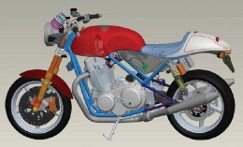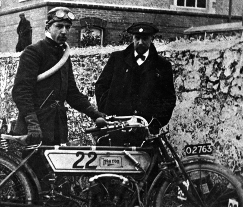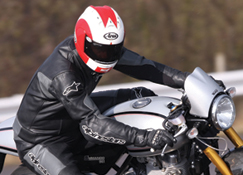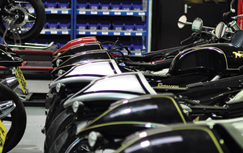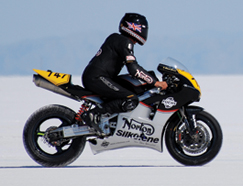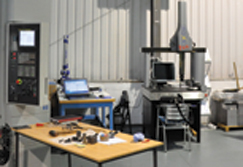Norton is a brand that resonates with many people who still feel an immense pride for this quintessentially British motorcycle manufacturer.
Following the success of the Commando 961SE, Norton has added two new production bikes to its Commando collection, one of which is the Commando 961 Café Racer
Founded in 1898 in Birmingham, the company has a long history of manufacturing both road and race bikes that have stood for performance and excellence.
Norton fans, many of whom still own a Norton bike, have certainly not forgotten its glory days and when in 2008 it was announced that the brand was returning to the UK after a recent tumultuous past, there was much talk about the rebirth of a legend.
Norton’s new home is in an industrial unit alongside the Donington Park Grand Prix Circuit in Derbyshire. From the outside, this low key metal shed doesn’t quite prepare you for what you’ll encounter inside: a shop floor filled with about twenty gleaming Nortons waiting to be delivered and a small workforce buzzing with activity.
The man responsible for bringing Norton back to British soil is UK businessman Stuart Garner, who purchased all the trademarks and development work relating to the brand in 2008.
Norton had been over in the US for the past 15 years where Kenny Dreer, a well-known restorer of vintage bikes, had set up a company in Portland, Oregon, specifically to develop a new Norton Commando road bike.
Although a number of prototype bikes had been designed, sadly not one went into production and in 2006 the company shut down. So, having sealed the deal in just four days, Garner bought a 15,000 square foot factory in Donington Park and started to recruit a brand new team to get his new venture up and running.
The first employee to come on board was Simon Skinner, Norton’s new head of design, who had previously been at Triumph for seven years working on many bikes including the 675 and the new Tiger 800. “I was the first employee here and then I nicked a couple of guys from Triumph other places.
We now have a really strong little team, which gives us a fighting chance of doing something really good,” he says.
Plan of attack
The plan was to first get the retro sports version of the popular 1960s and 1970s Commando model, which the Americans had invested so much money and time developing, into production.
This would then enable the team to start designing brand new Norton models. Although Skinner was very impressed with the styling of the prototype bikes it didn’t take him long to realise that they were not manufacturable.
Not one component could be carried over, which meant he would have to start from scratch. “We had to completely redesign it – every nut and bolt, engine and chassis,” he explains. “Although Stuart Garner picked up the brand thinking it was pretty much ready to go we soon discovered that was far from the case.
We would have loved nothing more than to have worked from the prototype and gone into production but it just wasn’t possible.” The biggest change that would have to be made was putting a new electronic fuel pump for the fuel injection as the carburettors were just not functional.
It was only really when he opened the CAD files of the prototype that he realised all the work that lay ahead of him.
As a Performance Partner of PTC’s VAR Inneo, Skinner had already negotiated a deal for two seats of Pro/Engineer, so although the CAD files had been created in the US using SolidWorks he was adamant that Norton should be a Pro/E house.
“Having used it before I knew that you can do pretty much everything you need to on a bike in Pro/E,” says Skinner. “There is also, of course, Mechanica and other useful features.” Within a year the team had remodelled it in Pro/E, redesigned it and tooled it.
The next stage was setting up a supply chain, which Norton wanted to source as locally as possible. “Selecting a supplier base for the Commando was as tough a job as redesigning the bike,” admits Skinner.
The reason for this was that motorbikes aren’t manufactured in the UK anymore and because they were only after a few hundred parts as opposed to thousands, the team had to seek out small engineering companies.
“We try and keep parts and components as British as we can. The theory is that if we can buy it in the UK then we will,” says Skinner. “If we can’t then we need to go to a premium supplier elsewhere in Europe as I don’t want to go to the Far East.”
At present the bike is about 70 to 80 per cent British with the engine being built in-house at Norton, frames made in Luton and the engine cases cast manufactured in Telford. Components sourced from suppliers outside of the UK include the Italian Brembo braking system, Swedish Ohlins shock absorbers and the carbon wheels from Blackstone Tek in South Africa.
These quality components don’t come cheap and the result is a high performance and premium bike that will set you back around £16,000. “We want to raise the game and be more of an Aston Martin brand than a Ford. Not everyone will be able to afford a Norton but I want everyone to want one,” says Skinner.
Made in Britain
Production on the Commando 961 SE started in March 2009 and the 30 strong staff set about making a couple of hundred bikes in the first year.
Due to its success another two models have now been added to the range – the Commando 961 Café Racer and Commando 961 Sport – but production will not be increased dramatically as Garner’s plan is not for Norton to mass produce products.
With two bikes being built per day, ten new Nortons are emerging from the factory each week. “We don’t want the values to grow to such an extent that we need another production line – we want to keep it as a hand built, niche product,” says Skinner.
In fact, at the recent NEC Motorcycle Show held at the end of November 2010, Norton showcased its hand-built credentials by running a CNC machine alongside the display of the bikes. This also highlighted the fact that Norton is the only UK bike manufacturer actually building its products in the UK.
So far there has been a huge interest in the range from both the motorcycle press, who have given it good reviews, and Norton fans. The bikes have even attracted some pretty high profile customers including Orlando Bloom, Bruce Springsteen and Top Gear’s Richard Hammond.
As Skinner says, it was as if there was a market out there just waiting for Norton to arrive. Many customers are also buying more than one bike – one to ride and one to display in their homes (one customer is even hanging it from a beam in his living room).
“We have a finance package for the bike but not one person has taken it out yet and we have guys buying two to three bikes at a time. That will dry up eventually but what that gives us is an association with the brand,” explains Skinner.
Done deal
With the type approval process almost complete, Norton has also set up a dealer network of nineteen dealerships worldwide for 2011.
With all of these dealers having put in their orders, the 2011 order book is now running to over 3,000. “We can’t make that many, we could make 2,000 at most,” says Skinner happy to keep it as an exclusive brand.
Inside the factory, together with the build room and design offices, there is a storeroom as well as a small machine shop. This houses a number of CNC machines supplied by Hardinge-Bridgeport as well as a Faro arm.
Currently, Norton is only machining a small amount of parts in-house. Also, having only recently discovered that its engine supplier cannot keep up with demand, a new engine build room has been erected outside where the components for the engines will now be assembled. This is no small endeavour as there are 265 unique components included in the total of 553 parts that are used to make the engine.
Obviously this news has caused some upheaval, and recent down-time in the factory, but Skinner believes that it’s for the best as it means that the engines will now both be designed and assembled in-house, so reducing costs and allowing for greater control.
“It’s much easier to scheme it out on CAD and get it made next door rather than having to go through a third party,” he comments.
This also meant Norton had to change the nature of its business as the plan was to not build the engine in-house. “But we will come out the other side,” smiles Skinner. “There is a big light at the end of the tunnel and the tunnel is getting shorter and the light is getting brighter.”
New designs
Now that Norton is successfully building its bikes in-house, Skinner is concentrating on the next range that will feature a completely new design.
The challenge is in ensuring that it looks modern and fresh but still has the Norton design DNA running through it. “It’s really tricky because how do you make it look like a Norton if there hasn’t been a modern Norton for 20 years?” asks Skinner. “It’s also quite a lot of responsibility because I don’t want to be the person responsible for messing up a 100 year old brand.”
Although Skinner won’t reveal what he has up his sleeve he does say that it will be out in two years, will look like an Aston Martin DB9 on two wheels and will cost in the region of £25,000. Skinner gets inspiration and ideas for these new bikes from various places but especially the automotive industry.
The design process then kicks off with his tools of choice – pen and paper. As well as sketching by hand he also uses Photoshop in these initial stages. From then on, the sketching and feasibility in CAD happens side by side.
“With the new bike I have been working on, I have laid it all out in CAD with a fully adjustable geometry part underneath,” says Skinner. “This means that I can change the position of the suspension and various bits, then put the engine in and wiggle it around to where I want it to be.
“Then I’ll do a side view in Photoshop. So, I’ll sketch out the bike and I think that looks a bit weird – the engine is in the wrong place and then do them completely side by side,” he explains.
For Skinner, designing the exterior of a motorbike is very different to that of a car. In a car the engineering is mostly hidden under the bonnet whereas on a naked bike it’s all exposed. For this reason he aims for Norton to be a design-led company. “We certainly need to have design right at the forefront of what the brand stands for,” he says.
As a result, it’s paramount that design and engineering are integrated right from the start.
“Having worked on projects from scratch at Triumph, as well as speaking to designers at other motorcycle manufactures, they are all the same in that the engineer is involved at the start of the project when they are briefed about it, then the stylist does the drawings and a 3D mock-up in clay or foam, then the engineer comes back onto the scene and will reverse engineer it into CAD,” he says. “So although the stylist’s job is now done, the engineering still has a long way to go.
For me that doesn’t work, they need to be completely integrated.” Being a small company with a passionate and dynamic team, and with a new stylist coming on board in early 2011, working this way will certainly be possible.
Racing ahead
When Garner set up his company he described it as a three-legged stool – one leg is building road bikes, one is racing and the other is licensing and merchandising around the brand name.
So although Skinner and his team are concentrating on road bikes at the moment, race bikes will also be very much a part of the brand. “Racing is at the heart of Norton with Rem Fowler having won the first Isle of Man TT in 1907 and we have raced bikes ever since,” he says.
Garner, who also owns Norton Racing Ltd, and in September 2009 broke the World Speed Record at the Bonneville Salt Flats riding a Norton NRV588, not only plans to bring Norton back to road races like the TT, but also in the ultimate bike racing championship, Moto GP.
Skinner has every confidence that Garner, with a string of successful businesses already under his belt – including fireworks, baby stroller and engineering firms – will bring Norton back from the brink and re-establish it as a premier British motorcycle brand.
In fact, the company is expanding and is currently looking out for designers and engineers to bring on board (see DEVELOP3D Jobs to find out more).
www.nortonmotorcycles.com

Norton – the rebirth of a legend

